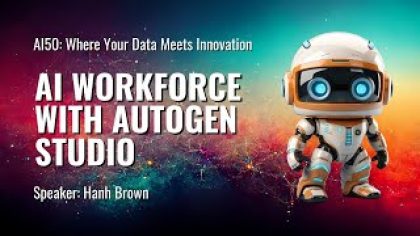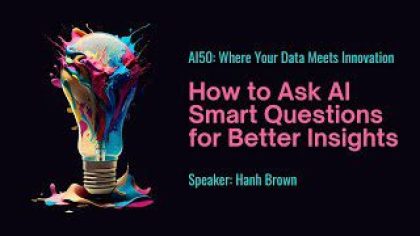Table of Contents
ToggleThe digital divide is a growing concern for older adults, who often struggle to keep up with the rapid pace of technological advancements. As a result, they risk being left behind in today’s highly connected world. Artificial intelligence (AI) has the potential to address this issue by providing accessible, user-friendly solutions tailored to the unique needs of senior citizens. By empowering older adults with AI education and technology, we can empower older adults with digital literacy and bridge the digital gap, ensuring they can fully participate in the modern world.
The impact of the digital divide on older adults is significant, with many experiencing feelings of isolation, frustration, and even depression. This is further exacerbated by the fact that seniors are often more reliant on technology for healthcare, social connections, and essential services. In a society that increasingly relies on technology for everyday tasks, it is vital that we address the digital divide and ensure that older adults can navigate the digital world with confidence and ease.
AI has shown great promise in various sectors, and its potential to alleviate the digital divide for seniors is no exception. By utilizing AI-driven education and technology, we can develop innovative tools and services that cater to the unique needs of older adults. This will not only help them become more digitally literate but also allow them to benefit from the many advantages technology has to offer.
However, to effectively bridge the digital gap, it is essential that AI-driven solutions are accessible and user-friendly for senior citizens. By keeping the target audience in mind and customizing content to suit their interests and needs, we can ensure that AI can truly empower older adults and prepare them for success in the tech world.
Empowering Older Adults with AI: Understanding the Digital Divide Among Older Adults

As the digital age advances, it becomes more critical to bridge the technological gap for older adults. AI technology, when understood and utilized effectively, can transform their lives, fostering independence and enhancing their overall quality of life. However, before we can fully harness this power, we must first understand the depth and implications of the digital divide among this population.
Barriers to Technology Adoption
Several barriers contribute to the digital divide among older adults, making it challenging for them to adopt and utilize modern technology. First and foremost, seniors often face physical limitations, such as reduced vision, hearing, and manual dexterity, which can make using devices and navigating interfaces difficult. In addition, cognitive decline may also hinder their ability to learn new skills and adapt to the ever-evolving tech landscape.
Another significant barrier is the lack of exposure and experience with technology. Many older adults did not grow up with the same level of access to technology as younger generations, making it harder for them to feel comfortable with digital devices and platforms. This unfamiliarity can lead to a lack of confidence and even fear of technology, which can further widen the digital gap.
Lastly, the cost of devices and internet access can be a financial obstacle for seniors on fixed incomes. Even if they are interested in embracing technology, the expense associated with purchasing and maintaining devices may be prohibitive.
The Importance of Digital Literacy for Seniors
Digital literacy is crucial for older adults, as it equips them with the necessary skills and knowledge to navigate the digital world confidently. By fostering digital literacy, seniors can access essential services such as healthcare, banking, and government programs. This can improve their overall quality of life and empower them to maintain their independence for longer.
Moreover, digital literacy can help older adults stay connected with family and friends, reducing feelings of isolation and loneliness, which are common among seniors. Through digital communication tools, they can maintain social relationships, share experiences, and stay informed about the lives of their loved ones.
Additionally, digital literacy can provide seniors with new opportunities for learning and personal growth. Access to online resources, courses, and educational tools can help them pursue new hobbies or interests, keeping their minds active and engaged.
In summary, digital literacy is essential for the well-being and autonomy of older adults. As technology continues to evolve, the importance of digital literacy will only increase, highlighting the need to address the digital divide and ensure that seniors are equipped to thrive in the tech world. This is where AI-driven education and technology can play a critical role in bridging the gap and empowering older adults.
AI-driven Solutions for Digital Literacy and Empowerment

Advances in artificial intelligence (AI) have led to innovative solutions that promote digital literacy and empowerment. These AI-driven tools democratize access to education, enabling personalized learning experiences regardless of geographical boundaries. Such technology also fosters digital inclusion, ensuring people of all ages and abilities can effectively participate in today’s increasingly digital world.
AI-powered Learning Platforms and Tools
AI-powered learning platforms and tools offer a unique opportunity to address the digital literacy gap among older adults. These platforms can customize learning experiences to suit the specific needs and preferences of seniors, ensuring that content is engaging, relevant, and easy to understand. For example, AI-driven algorithms can analyze users’ learning patterns and adapt the curriculum accordingly, providing personalized content and pacing.
Furthermore, AI-powered tools can offer interactive and immersive learning experiences, such as virtual tutors or chatbots, that guide seniors through various topics and tasks. These AI-driven educators can answer questions, provide feedback, and encourage learners in real-time, making the learning experience more enjoyable and effective.
By leveraging AI-powered learning platforms and tools, older adults can acquire digital skills at their own pace, in a comfortable and supportive environment. This not only helps them become more digitally literate but also empowers them to confidently navigate the tech world and benefit from its many offerings.
AI-driven Accessibility Solutions
AI-driven accessibility solutions can greatly enhance the usability of technology for older adults, breaking down barriers and bridging the digital divide. For instance, AI-powered speech recognition and natural language processing can facilitate voice-activated interfaces, allowing seniors with reduced vision or manual dexterity to interact with devices more easily.
Additionally, AI-driven image and object recognition can provide real-time descriptions of visual content for visually impaired users, making it simpler for them to understand and engage with digital media. Similarly, AI-powered captioning and transcription services can make audio content more accessible for those with hearing impairments.
AI can also be utilized to design adaptive user interfaces, which automatically adjust to the unique needs and preferences of individual users. For example, an AI-driven interface could enlarge text or buttons, simplify navigation, or offer alternative input methods based on a user’s specific requirements.
AI-driven solutions have the potential to significantly impact digital literacy and empowerment among older adults. By harnessing the power of AI in education and accessibility, we can ensure that seniors have the necessary tools and resources to confidently participate in the digital world. This, in turn, will help bridge the digital divide, improve the quality of life for older adults, and contribute to a more inclusive and connected society.
The Benefits of AI in Bridging the Digital Divide for Older Adults

AI is playing a pivotal role in bridging the digital divide for older adults, making technology more accessible and intuitive for this demographic. Through voice-assistants, AI-powered health monitoring systems, and personalized learning platforms, seniors can enjoy the benefits of the digital era. This technology not only enhances their quality of life but also promotes their independence, social connectivity, and cognitive health.
Enhanced Access to Information and Services
AI-driven solutions can significantly enhance access to information and services for older adults, helping them navigate the digital landscape with ease. AI-powered search engines and recommendation systems can simplify the process of finding relevant content, making it easier for seniors to access crucial information on healthcare, finances, and other essential services.
Moreover, AI can streamline complex tasks, such as scheduling appointments, managing medications, or paying bills, through the use of virtual assistants and chatbots. These AI-driven tools can provide step-by-step guidance and support, ensuring that seniors can complete tasks efficiently and with minimal frustration.
By facilitating access to information and services, AI-driven solutions not only empower older adults with digital literacy but also enable them to make informed decisions and better manage their lives. This ultimately contributes to a greater sense of autonomy and confidence in the digital world.
Improved Communication and Social Connectivity
AI has the potential to improve communication and social connectivity for older adults, reducing feelings of isolation and loneliness that often accompany aging. AI-driven communication tools, such as voice-activated messaging, video calls, and virtual social spaces, can make it easier for seniors to stay in touch with family and friends.
In addition, AI-powered language translation and transcription services can break down language barriers, enabling older adults to communicate with a broader network of people. This can foster new connections and provide opportunities for cultural exchange, further enhancing seniors’ social lives.
By promoting communication and social connectivity, AI-driven solutions help older adults maintain strong relationships, share experiences, and stay engaged with their communities. This, in turn, can improve mental well-being and overall quality of life.
Increased Independence and Quality of Life
AI-driven technologies can significantly increase independence and quality of life for older adults. For instance, AI-powered home automation systems can enable seniors to control appliances, lighting, and security features using voice commands or simplified interfaces. This can make daily tasks more manageable, especially for those with physical limitations or mobility issues.
Furthermore, AI-driven health monitoring devices, such as wearable sensors and smart medical equipment, can help seniors manage their health more effectively. These tools can track vital signs, remind users to take medications, and alert caregivers or medical professionals in case of emergencies. This proactive approach to healthcare can contribute to a healthier, more independent lifestyle for seniors.
AI can also support seniors in maintaining their cognitive abilities through personalized brain training programs and mental stimulation. Access to AI-driven educational resources and learning platforms can help older adults stay mentally sharp and engaged, fostering a sense of accomplishment and personal growth.
AI-driven solutions have the potential to significantly benefit older adults by enhancing access to information and services, improving communication and social connectivity, and increasing independence and quality of life. By harnessing the power of AI to bridge the digital divide, we can ensure that seniors are empowered and well-equipped to thrive in today’s tech-driven world.
The Challenges and Limitations of AI in Addressing the Digital Divide
While AI-driven solutions hold immense potential for bridging the digital divide among older adults, there are still challenges and limitations to be considered. These include the need for human support and interaction, ethical considerations, and ensuring data privacy and security.
The Need for Human Support and Interaction
AI-driven solutions, though powerful, cannot entirely replace the need for human support and interaction in addressing the digital divide among seniors. Older adults may require personalized assistance, empathy, and emotional support that AI cannot fully provide. For example, seniors learning new technologies may benefit from the encouragement and patience of human instructors, who can adapt their teaching style to the individual’s needs and preferences.
Moreover, some older adults may be hesitant to trust or rely on AI-driven tools, feeling more comfortable interacting with a human who can understand their concerns and provide tailored guidance. Building trust in AI-driven solutions may be a gradual process that requires ongoing support from human caregivers, family members, and community resources.
To maximize the benefits of AI-driven solutions for older adults, it is essential to recognize the value of human support and interaction in tandem with AI technology. By combining the strengths of both, we can create a more comprehensive and effective approach to bridging the digital divide for seniors.
Ethical Considerations in AI-driven Solutions
As with any technology, ethical considerations must be taken into account when developing and implementing AI-driven solutions for older adults. One concern is the potential for AI to perpetuate or exacerbate existing biases, as AI algorithms are often trained on data that may contain discriminatory patterns. This can result in unfair treatment or exclusion of certain groups, further widening the digital divide.
To address this issue, it is crucial to ensure that AI-driven solutions are designed with fairness, inclusivity, and transparency in mind. Developers must carefully consider the data used to train AI algorithms and implement measures to mitigate potential biases.
Another ethical consideration is the risk of over-reliance on AI-driven solutions, potentially leading to a loss of human touch and empathy in care and support for older adults. It is vital to strike a balance between leveraging the benefits of AI technology and maintaining the essential human elements that contribute to seniors’ well-being and quality of life.
Ensuring Data Privacy and Security
Data privacy and security are significant concerns when using AI-driven solutions, particularly for older adults who may be more vulnerable to digital threats. As AI technologies often rely on large amounts of personal data to provide customized experiences, there is an inherent risk of data breaches, unauthorized access, or misuse of information.
To address these concerns, it is essential to implement robust data protection measures when developing and deploying AI-driven solutions for seniors. This may include the use of encryption, secure storage, and strict access controls to safeguard users’ personal information.
Furthermore, it is crucial to educate older adults on best practices for protecting their data and privacy when using AI-driven tools and services. By raising awareness and providing guidance on digital security, we can empower seniors to make informed decisions and use AI-driven solutions with confidence.
While AI-driven solutions offer promising opportunities to bridge the digital divide for older adults, it is essential to consider the challenges and limitations that may arise. By addressing the need for human support and interaction, considering ethical implications. And ensuring data privacy and security, we can create a holistic and effective approach to empowering seniors in the digital world.
Recommendations for Implementing AI Solutions to Bridge the Digital Divide
To successfully implement AI solutions that bridge the digital divide for older adults, a comprehensive approach is needed. This involves fostering collaboration between AI developers, government, and senior care organizations, prioritizing user-centered design and accessibility, and supporting continuous learning and adaptation.
Fostering Collaboration Between AI Developers, Government, and Senior Care Organizations
Collaboration between AI developers, government agencies, and senior care organizations is crucial for ensuring that AI-driven solutions effectively address the needs of older adults. By working together, these stakeholders can develop policies and initiatives that promote digital literacy and accessibility for seniors.
Collaborative efforts should focus on identifying specific challenges faced by older adults. Creating targeted programs and resources, and evaluating the impact of AI-driven solutions on seniors’ well-being and quality of life. Sharing knowledge, expertise, and resources across sectors can accelerate the development and implementation of AI technologies tailored to the unique needs of older adults.
Prioritizing User-centered Design and Accessibility
User-centered design and accessibility should be at the forefront of AI-driven solution development for older adults. By prioritizing the needs and preferences of seniors, developers can create tools and platforms that are intuitive, engaging, and easy to use.
Key considerations for user-centered design include ensuring that AI-driven solutions accommodate physical limitations, cognitive decline, and potential lack of familiarity with technology. This may involve developing voice-activated interfaces, simplifying navigation, and offering alternative input methods.
In addition, accessibility features such as adjustable font sizes, high-contrast visuals, and captions for audio content should be incorporated into the design of AI-driven tools and platforms. By prioritizing user-centered design and accessibility, developers can create solutions that empower older adults to confidently navigate the digital world.
Supporting Continuous Learning and Adaptation
Supporting continuous learning and adaptation is essential for the successful implementation of AI-driven solutions in bridging the digital divide for older adults. As technology continues to evolve, it is vital to ensure that seniors can keep up with the latest advancements and maintain their digital literacy.
To achieve this, AI developers and senior care organizations should collaborate to create ongoing educational resources, workshops, and support services. That helps older adults adapt to new technologies and stay engaged in the digital world. These programs should be tailored to the specific needs of seniors, taking into account their varying levels of experience and comfort with technology.
In addition, AI-driven solutions themselves should be designed to adapt and learn from user interactions. By continuously refining algorithms and interfaces based on user feedback and performance. Developers can create AI-driven tools that remain relevant, effective, and user-friendly for older adults.
Implementing AI solutions to bridge the digital divide for older adults requires a multifaceted approach. That involves fostering collaboration, prioritizing user-centered design and accessibility, and supporting continuous learning and adaptation. By addressing these key factors. We can ensure that AI-driven solutions empower seniors to thrive in the digital world, ultimately improving their well-being and quality of life.
Also read: AI in Bridging Senior Resource Access & Tackling Inequality
FAQs
What is the digital divide?
The digital divide refers to the gap between individuals who have access to and can effectively use digital technologies and those who cannot. This divide can be due to factors such as income, education, age, or geographic location. Older adults, in particular, often face challenges in accessing and using digital technologies, which can exacerbate the digital divide.
How does AI help bridge the digital divide for older adults?
AI-driven solutions can help bridge the digital divide for older adults by enhancing digital literacy. Improving accessibility, and providing personalized learning experiences. AI-powered platforms can tailor content and pacing to individual needs, making it easier for seniors to learn and adapt to new technologies. Additionally, AI-driven accessibility features, such as voice-activated interfaces and adaptive user interfaces. It can make technology more user-friendly and accessible for older adults.
What are some challenges and limitations of using AI to address the digital divide among seniors?
Challenges and limitations of using AI to address the digital divide among seniors include the need for human support and interaction. Ethical considerations, and ensuring data privacy and security. While AI-driven solutions can be powerful tools, they cannot entirely replace empathy, emotional support. And personalized assistance provided by human caregivers and instructors. Moreover, ethical concerns related to fairness, inclusivity, and potential over-reliance on AI must be addressed, as well as ensuring robust data protection measures.
How can collaboration between AI developers, government, and senior care organizations benefit older adults?
Collaboration between AI developers, government agencies, and senior care organizations can accelerate the development. And implementation of AI-driven solutions tailored to older adults’ unique needs. By working together, these stakeholders can identify specific challenges faced by seniors. Create targeted programs and resources, and evaluate the impact of AI-driven solutions on their well-being and quality of life.
How can we ensure that AI-driven solutions are accessible and user-friendly for older adults?
Prioritizing user-centered design and accessibility is essential for creating AI-driven solutions that are accessible and user-friendly for older adults. This involves accommodating physical limitations, cognitive decline, and potential lack of familiarity with technology by developing voice-activated interfaces. Simplifying navigation, and offering alternative input methods. Incorporating accessibility features, such as adjustable font sizes, and high-contrast visuals. And captions for audio content, can further enhance the usability of AI-driven tools for seniors.
References
- https://thedocs.worldbank.org
- https://www.oecd.org
- https://www.unesco.org




-qmbs5n2xf3phdge81somleabvf62vb440rax2cr684.png)
-qmbs5jbknrkc30jonr24bf8hhvom0ip6o8oz58wqx0.png)












4 Comments
[…] engaging family members and caregivers in seniors’ digital literacy education is crucial. By providing them with the tools and resources to support their loved ones, […]
[…] Digital literacy is crucial for seniors to navigate and benefit from technology effectively. By improving their digital skills, seniors can access information, resources, and services to enhance their quality of life and promote independence. As technology continues to advance, the importance of digital literacy for seniors will only grow, making it essential for them to keep up with evolving technologies and applications. […]
[…] Digital literacy is a significant barrier for many seniors. Complex interfaces or unfamiliar technology can be daunting, resulting in reluctance to use AI-driven solutions. To address this, it’s essential to promote digital literacy among seniors. This could involve offering training sessions or workshops, developing easy-to-follow user manuals, or designing AI tools with intuitive, user-friendly interfaces. […]
[…] pozri viac: https://theaging.ai/articles/empowering-older-adults-with-ai/ […]